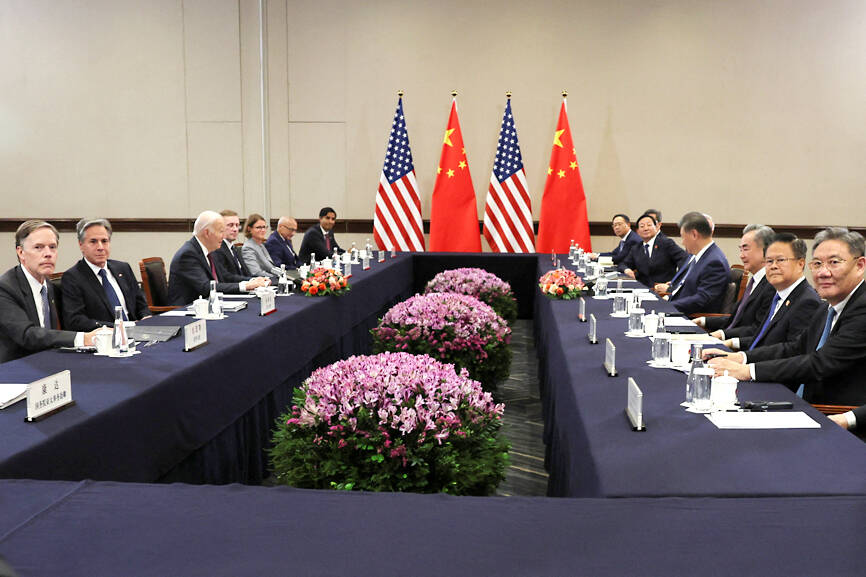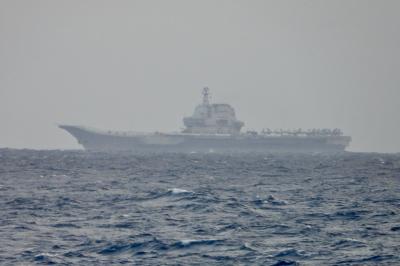China’s military intimidation and economic coercion against Taiwan are the main causes of tensions that are destabilizing peace in the Taiwan Strait, Taipei said yesterday while thanking US President Joe Biden for expressing Washington’s firm stance of maintaining peace and stability in the region.
Biden and Chinese President Xi Jinping (習近平) met on Saturday for their third meeting and their first talks in seven months on the sidelines of the APEC forum in Lima, Peru.
It was likely Biden’s last meeting as president with Xi.

Photo: Reuters
During their conversation, Biden reiterated the US’ opposition to any unilateral change to the “status quo” from either side, that it expects cross-strait differences to be resolved peacefully and that the world has an interest in peace and stability in the Taiwan Strait.
Biden also called for an end to destabilizing military activity by the People’s Republic of China (PRC) around Taiwan.
Xi told Biden that the “Taiwan issue, democracy and human rights, pathways and systems, and development interests are China’s four red lines that must not be challenged,” according to state-run China Central Television.
“These are the most important guardrails and safety net for China-US relations,” Xi said.
“The separatist actions of ‘Taiwan independence’ are incompatible with peace and stability in the Taiwan Strait,” he added.
Xi also told Biden that Washington “should not intervene in bilateral disputes ... and not condone or support provocative impulses” in the South China Sea.
He also said that China’s position on the war in Ukraine was “open and aboveboard” and that Beijing would not allow tensions on the Korean Peninsula to “descend into conflict or chaos,” the broadcaster reported.
China would “strive for a smooth transition” in relations with the US and is ready to work with the incoming administration of US president-elect Donald Trump, Xi said.
In Taipei, the Mainland Affairs Council yesterday said that the Chinese Communist Party (CCP) posed several challenges, including military intimidation and economic coercion, that affect security and stability in the Indo-Pacific region, and are part of an attempt to force others to accept Beijing’s political views.
“Beijing wants to change the rules-based international order, and that has attracted widespread attention from the international community,” it said. “This is also the main cause of tensions in cross-strait relations and instability in the Taiwan Strait.”
The council said that the government’s cross-strait policy seeks steady, pragmatic and consistent relations with China, as well as the prosperity and development of the Indo-Pacific region, which has been affirmed by mainstream public opinion in Taiwan and the international community.
“In the face of the CCP’s continued aggression toward Taiwan, we will stand firm in protecting the constitutional system of the Republic of China” (ROC), it said. “We will maintain the status quo and we will resolutely safeguard national sovereignty and dignity.”
Beijing should pragmatically face the facts of the current situation across the Strait, abandon coercive claims and actions, and engage in meaningful dialogue with Taiwan’s democratically elected government to resolve differences, it added.
China is the biggest destabilizing force in the Indo-Pacific region, the Ministry of Foreign Affairs (MOFA) said in a separate statement.
“The ministry also thanks the Biden administration for affirming the importance of maintaining peace and stability in the Indo-Pacific region and for continuing to take concrete actions to maintain it,” it said.
Those actions include a joint statement by Japan, South Korea and the US issued on Friday, which reiterated that “peace and stability across the Taiwan Strait is an indispensable element of security and prosperity in the Indo-Pacific region,” it said.
The three countries also established the Trilateral Cooperation Secretariat, responsible for coordinating and implementing their shared commitments, including working together to ensure the region is thriving, connected, resilient, stable and secure, it added.
The ministry also addressed a news release issued by the Chinese Ministry of Foreign Affairs that it said included misleading claims about Taiwan and Taiwan-US relations.
The MOFA reiterated that “the ROC and the PRC are not subordinate to each other.”
“As the US and other countries have repeatedly pointed out, China, which continues its provocative military actions surrounding Taiwan, is the biggest source of tension that is undermining peace and stability in the region and posing a serious threat to global economic prosperity,” the ministry said.
It said it welcomes the international community’s concerns over China’s efforts to threaten the “status quo” in the region and calls for peace and stability in the Taiwan Strait.
As a responsible member of the international community, Taiwan would implement its “four pillars of peace” plan to enhance its self-defense capabilities, it said.
Taiwan would also work with the US and like-minded countries to ensure peace, stability and prosperity in the Taiwan Strait and Indo-Pacific region, it added.
Additional reporting by AFP, Chen Yu-fu and Huang Ching-hsuan

AIR SUPPORT: The Ministry of National Defense thanked the US for the delivery, adding that it was an indicator of the White House’s commitment to the Taiwan Relations Act Deputy Minister of National Defense Po Horng-huei (柏鴻輝) and Representative to the US Alexander Yui on Friday attended a delivery ceremony for the first of Taiwan’s long-awaited 66 F-16C/D Block 70 jets at a Lockheed Martin Corp factory in Greenville, South Carolina. “We are so proud to be the global home of the F-16 and to support Taiwan’s air defense capabilities,” US Representative William Timmons wrote on X, alongside a photograph of Taiwanese and US officials at the event. The F-16C/D Block 70 jets Taiwan ordered have the same capabilities as aircraft that had been upgraded to F-16Vs. The batch of Lockheed Martin

US President Donald Trump yesterday announced sweeping "reciprocal tariffs" on US trading partners, including a 32 percent tax on goods from Taiwan that is set to take effect on Wednesday. At a Rose Garden event, Trump declared a 10 percent baseline tax on imports from all countries, with the White House saying it would take effect on Saturday. Countries with larger trade surpluses with the US would face higher duties beginning on Wednesday, including Taiwan (32 percent), China (34 percent), Japan (24 percent), South Korea (25 percent), Vietnam (46 percent) and Thailand (36 percent). Canada and Mexico, the two largest US trading

GRIDLOCK: The National Fire Agency’s Special Search and Rescue team is on standby to travel to the countries to help out with the rescue effort A powerful earthquake rocked Myanmar and neighboring Thailand yesterday, killing at least three people in Bangkok and burying dozens when a high-rise building under construction collapsed. Footage shared on social media from Myanmar’s second-largest city showed widespread destruction, raising fears that many were trapped under the rubble or killed. The magnitude 7.7 earthquake, with an epicenter near Mandalay in Myanmar, struck at midday and was followed by a strong magnitude 6.4 aftershock. The extent of death, injury and destruction — especially in Myanmar, which is embroiled in a civil war and where information is tightly controlled at the best of times —

China's military today said it began joint army, navy and rocket force exercises around Taiwan to "serve as a stern warning and powerful deterrent against Taiwanese independence," calling President William Lai (賴清德) a "parasite." The exercises come after Lai called Beijing a "foreign hostile force" last month. More than 10 Chinese military ships approached close to Taiwan's 24 nautical mile (44.4km) contiguous zone this morning and Taiwan sent its own warships to respond, two senior Taiwanese officials said. Taiwan has not yet detected any live fire by the Chinese military so far, one of the officials said. The drills took place after US Secretary